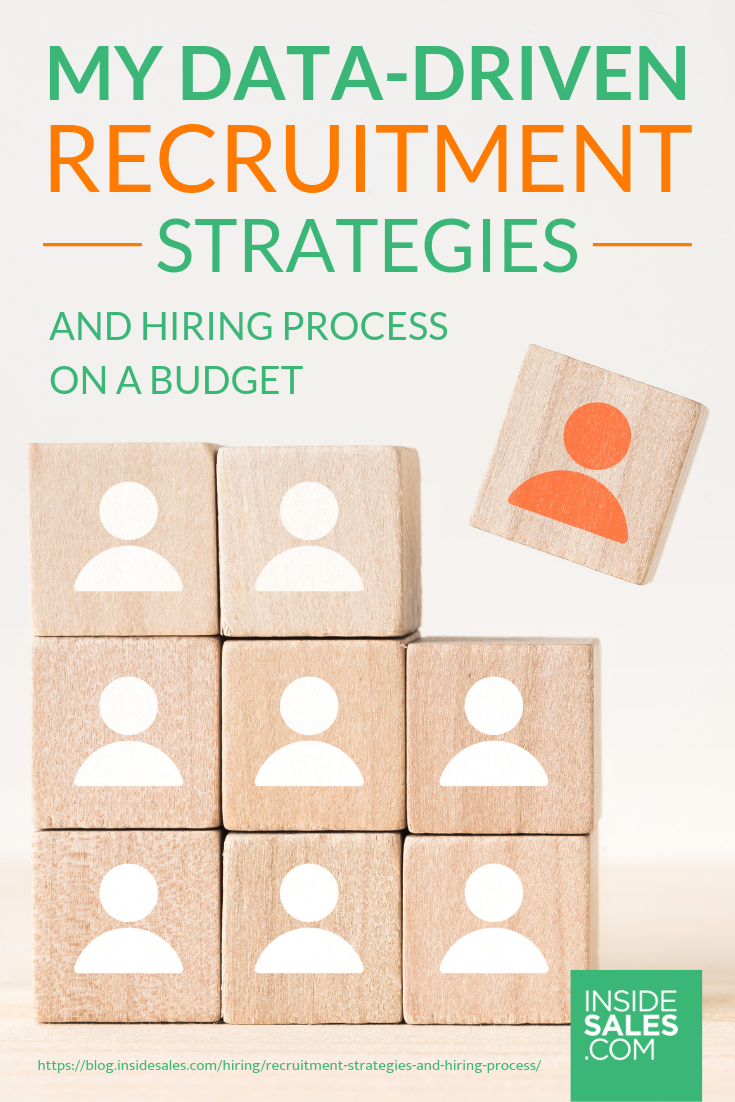My Data-Driven Recruitment Strategies And Hiring Process On A Budget
Xant Team
Today, I’ll share with you the budget-friendly recruitment strategies and hiring process we implemented, which allows us to hire based on objective data. Keep reading to find out more.
RELATED: Why You Need Data Driven Hiring…NOW!
In this article:
- Our Recruitment Strategies and Hiring Process
- The Three Phases of Our Hiring Process
- Coming up with a Recruitment Plan Based on Our Current Talent Pool
- The Characteristics We Look for in a Sales Rep
How to Improve Sales Operations With Better Recruitment Strategies
Our Recruitment Strategies and Hiring Process
I’ve taken over the Business Development Team here at XANT, and one of my tasks is to hire people for our team.
I’m familiar with the standard hiring process — we interview the candidate for about 30 minutes, then make a decision that could determine our sales team’s success.
Personally, I hate this process, which is why I started to look for better ways to hire new people so we can double the size of our team.
I wanted to take things to the next level so that hiring doesn’t feel so subjective. At the same time, I wanted to optimize for efficiency while keeping costs at a minimum.
To achieve this, we incorporated two new steps as part of our recruitment strategies and the hiring process as a whole.
1. Personality Test
The very first thing I did to improve our hiring process is to incorporate a personality test. For this, I chose the Big Five Personality Test.
I am a big believer in talent — I know this can be productively applied and also unproductively applied. Talents are those innate abilities that people have, which I don’t think any of us are great at immediately discovering.
That is why having our candidates take a personality test was important — we can use this as a pre-filter to help us figure out the DNA of candidates we want or don’t want.
I need to put out a disclaimer, though. I’m not saying that it’s a must to use a personality test when hiring.
There’s certainly a number of things you should watch out for when you use this tool in hiring, so I’d advise you to be conscientious.
2. Hiring Calibration with Human Resources (HR)

The second improvement I implemented was to directly and intentionally work with the HR team. It’s not only us who recruit and hire people — it’s a shared responsibility with HR.
Our goal is to have effective recruitment strategies and practices in place. That is why we need to be on the same page when it comes to pre-screening candidates.
This initial process doesn’t have to be extremely complicated. To align, we organized a meeting with our HR team and did a hiring calibration.
As a result, we agreed that the pre-screening criteria would be mostly based on how much experience the candidates had.
The Three Phases of Our Hiring Process
We’ve established three phases when it comes to hiring business development reps for our team. I’ll take you through each phase so you can also see which practices could work with your own hiring process.
Phase 1: Pre-Screening Interview, Big Five Personality Test, and Role-Playing
There are three steps in Phase 1 of our hiring process. First is the pre-screening interview with HR, which is part of our recruitment strategy plan.
Here, they ask the basic pre-screening questions we’ve agreed upon and calibrated with them. They also find out how the candidates handle themselves on the phone.
Next, the candidates take the Big Five Personality Test. This goes through five personality aspects:
- Openness
- Conscientiousness
- Extraversion
- Agreeableness
- Neuroticism
Once we get the results, we compare them against our top performers’ results (more on this later).
The last step is preparing the candidates for an in-depth role-play assessment. We make sure to brief them before we let them go through this process.
After implementing this, we found out two things:
- The role play assessment wasn’t something we preferred to do off the bat. In some cases, it worked well, but sometimes it didn’t.
- To prepare the candidates, we had to give them some basic guidelines on the method we use. We’re kind of a Sandler Training Shop here, so we give them links and examples to study. Note, though, that we don’t give them a full script because we want them to show their drive and determination to go through the role play.
Phase 2: In-Person Interview

The second phase is the in-person interview. Now, the way we do this deviates from the usual hiring interview process.
I don’t know about you, but we’ve had some problems before when we had our candidates go through back-to-back interviews with different people. That’s why we determined that it’s best to have a panel interview instead.
Often, the people who conduct the interviews are me and some of my Business Development Managers. We interview candidates together, which we found to be more effective.
When we came up with the idea of doing a panel interview, we also thought about the questions we’ll ask. The purpose of the in-person interview was to determine if the candidate was right for our team.
RELATED: How to Use Technology to Scale Your Sales Team w/Christopher Fago @Palo Alto Networks
Assessment Areas for Candidates
We brainstormed on this, and came up with the following assessment areas:
- Education Level — We debated over this and eventually decided to have HR include this in their pre-screening instead, as we don’t believe it should be a prerequisite for hiring somebody.
- Eagerness to Learn — Is the person an active learner?
- Achievement — What is their biggest achievement in life, so far?
- Passion — Do they have something they’re crazy about outside of work? I’ve always believed that if somebody’s got a passion outside of work, I can make them use that passion for work.
- Sales Experience — We want to know how much or how little experience they have in sales. This is always going to be an important aspect.
- Volunteer Experience — How do they spend their time for others? Do they participate in outreach activities?
- Technology — We want to know how tech-savvy a candidate is because we found out in our own business that if people are better with technologies, they pick up information quicker. We also realized that people who are better with technologies, whether that’s Salesforce.com or engagement tools, just have a quicker speed that helps them hit the ground running.
These are the calibrated questions we use for our in-person interview. We take turns asking different questions, and we all hear the same answers.
Perhaps the most important factor is we all get the same experience out of the interview.
Phase 3: Assessing the Candidate and Making a Decision
Phase 3 happens immediately after the in-person interview in Phase 2. We ask the candidate to leave the room for a while.
Then, each person present in the interview fills out a scoring methodology on the different characteristics we look for in a business development rep.
We talk about the scores we gave, we calibrate, and finally, we make a decision. It’s a “yes” or “no” decision that we’re confidently making based on data we’ve gathered on the candidate.
Coming up with a Recruitment Plan Based on Our Current Talent Pool
Let’s go back to the time when we were only beginning to implement our new recruitment strategies and hiring process.
After we came up with the assessment areas for the in-person interview, we did a fascinating exercise. We sat down with each of our current business development and sales development reps and interviewed them.
One of the most important aspects of that exercise was to have our current reps take the Big Five Personality Test. We used their results as a benchmark for our sales rep candidates.
The goal is to figure out the characteristics of a top performer, so we’ll know what to look for when hiring. We studied our own team, the top performers, in particular, to figure out what their innate talents are and what makes them tick.
Through the exercise we did, we came up with additional assessment areas:
- Competition — Having previous competitive experience, whether in a sports team or otherwise, is quite important to us. This is because a lot of our high performers had experiences in competing.
- Culture — We want to figure out if the person will fit within our culture. For this, we came up with the question, “How would your closest friends describe you?”
We even had our reps play a “Twenty Questions”-type of game. We picked a random object within the room and had them guess what we were referring to using the clues we give.
The better performers in our team usually figured it out after 10 questions. Some people gave up after five questions, and some even downright refused to do it.
It’s an interesting way to gather data on our current talent pool.
The Characteristics We Look for in a Sales Rep
After going through the exercise with our current reps in InsideSales, we started to see patterns emerge. That allowed us to determine what attributes we look for in a sales rep, which we can also score after an interview:
- Drive — We determine this by asking the candidates about their biggest achievement.
- Experience — We have a rating scale for this where we find out how much sales experience they have.
- Competition — We find out if they have any competitive background.
- Learning — Are they actively learning? Are they inquisitive? Do they care and ask questions? Are they trying to learn new things that will make them a better person?
- Culture — How do they fit in our culture? Who do they think they are? What kind of attributes do we want in our culture, and what have we found to be successful?
- Personality Test — The Big Five Personality Test
- Experiential — How well did they do on the role-play activity?
These comprise the scoring methodology I mentioned in Phase 3.
The new recruitment strategies and hiring process we have in place are working more effectively for us. My Management Team and I are all on the same page as to what “good” looks like because we calibrated.
It also helped that we were able to study our own team. Having this type of subjective/objective process with a little bit of data makes a great version of a data-driven hiring process.
What effective recruitment and hiring strategies do you implement in your own business? We’d love to hear from you in the comments section below!
Up Next:
- How to Optimize an Inherited Sales Team w/Brad Moore @PersonifyCorp
- 10 Secrets of Successful Business Sales Development Leaders [INFOGRAPHIC]
- How to Optimize Team Performance with Sales Dashboards
